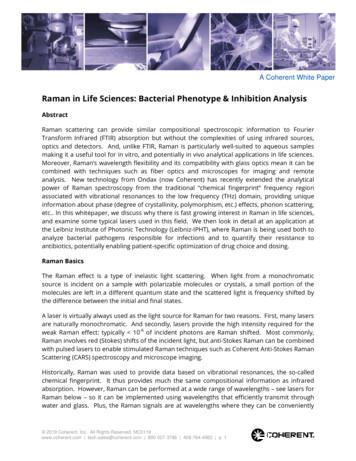Multimodal Coherent Raman Spectroscopy & 3D Microscopy
Multimodal Coherent RamanSpectroscopy & 3D Microscopy:Nonlinear Optical Tools for Geoscience ResearchAlbert Stolow, A.D. Slepkov, A. Pegoraro, Robert C. BurrussNational Research Council Canada& USGS
MicroscopygMoleculesof Organicin RockIn order to image the micro-world,micro world we will need two things:(1) Spatial resolution((2)) ContrastProblems:(1) Prefer to use visible light, UV absorbed and scattered(2) Features may be small: 1 m.1 m. IR wavelength too long.(3) Organic inclusions do not come colour-coded for ourviewinggppleasure .(4) How can we get molecule-specific contrast?
How can we achieveMoleculeSpecific Imaging? Want to avoid exogenous labels (dyes, stains, markers) Fluorescence (electronic, X-ray) spectroscopy of organicmolecules in condensed phases is NOT specific enough Magnetic Resonance does NOT have required spatialresolution
Molecular VibrationsareMolecular Fingerprints
The Raman EffectC.V. Raman1928The Inelastic Scattering of LightSpontaneousRaman ScatteringStokesAntiStokesMolecularVibrationRaman Spectroscopy probes Molecular Vibrations
Challenges withRaman Microscopy The Raman effect is famously insensitive Any fluorescence background can completely overwhelmthe Raman signal Raman microscopy generally insensitive tocrystallographic features: edges, cracks, grain boundaries
A New Tool:Non-linearNonlinear OpticsApply an intense laser electric field to matter.Expand the material response in powers of the electric field EP 0 ( (1) E (2) E2 (3) E3 )linearresponsenonlinearresponseThe linear response gives us things we know well.refractivef ti indexi d andd theh absorptionbti coefficientffi i tWhen E is small (weak laser field), E2 , E3 etc. are negligibleThe nonlinear response brings many new opportunities.Important (useful) when E gets large, as in an ultrashort laser pulse
2nd Order Nonlinearities The incident optical fieldE (t ) E1 (t ) E2 (t ) Nonlinear polarization contains the following terms( 2) 2 P (2 1)E1((SHG))( 2) 2 P (2 2 )E2(SHG)( 2) P( 12E1 E22)(SFG)P ( 1 - 2 ) 2 ( 2 ) E1 E2*((DFG))P ( 0 ) 2 ( 2 ) ( E1 E1* E2 E2* ) (OR)
Two Photon MicroscopyPhotomultipliertube ConfocalCfl scanningimicroscopeFemtosecond Ti:SaoscillatorcondenserfiltersampleDetect Signals2nd Harmonic (SHG)2hv fluorescence (TPEF)objectiveopticalscannersSHG: Sensitive to cracks, grain boundaries etc.TPEF: Sensitive to higher organicsTi:Sa laser
3rd Order NonlinearitiesWhen the general form of the incident electric field is - i 1t - i 3t- i 2t E3eE( t ) E1eE2 eThe third order polarization can have 22 componentscontaining the following frequencies: i ,3 i , ( i j k ),) ( i j k )( 2 i j ), ( 2 i j ), i, j , k 1,2,3CARS
Coherent Anti-StokesgRaman Scattering A 3rd order non-linear opticalpversion of Raman Spectroscopyppy Optimally used with ultrashort laser pulses CARS signal is a coherent laser pulse, blue-shifted and spatiallydistinct from all other light sources.2 Input Colours: Pump & StokeskAnti-Stokesh Anti-StokesSamplekStokeskPump Raman Shift2x Pump – Stokes AntiStokes
CARS Microscopy Non-linear Optical MicroscopyMicroscopy.Enhanced 3D spatial resolutionCARS Microscopy has chemical selectivity via Raman mode resolutionCARS Microscopy is 104 times more sensitive than Raman microscopyLABEL FREE. Vibrational contrast means fluorescent probes unnecessary.MINIMAL DAMAGE.DAMAGE No linear absorption. Photobleaching is circumvented:no heating effects.FLUORESCENCE FREEFREE. CARS signal is higher in frequency than one-photonfluorescence, so it can be detected in the presence of a strong fluorescentbackground.DEEPER PENETRATION. Reduced absorption, scattering of the near-infraredexcitation beams.
CARS MicroscopyMade SimpleOptics Express 17, 2984 (2009)
Multimodal PF500nmEPIPMTSHG400nmSecond Harmonic 2-PhotonFluorescence CARSFemtosecondTi:Sa LaserPhotonicCrystal FiberSome OpticsIn a BoxSTOKES1060nmPulse ShapingOpticsPUMP800800nm
Firsty AvailableCommerciallyCARS MicroscopeReleasedOctober2009
CARS User Facilitywww.CARSLab.ca
Biomedical Applicationsof Multimodal CARSAtherosclerosisReal Time Z-scanmovie: 50 m Red is CARS(2845 cm-1)(lipids droplets)Blue iis SHGBl(collagen)Green isGi epii TPF(elastin)
Geoscience Applications?ppFluid Inclusions? Fluid inclusions provides information about the conditionsexisting during formation Host matrices can be amber, ice,quartz, calcite, feldspar, and manyother “rock” materials. Formation occur at variousconditions:Temperature can be 102 - 103 CPressure can be 104 atmvapourquartzImage: wikipediamineralfluid
Yes we can.First Application ofCARS Microscopyto Geosciences
Multimodal CARSpy of RocksMicroscopyUsing CARS we demonstrate four “firsts” in Geology:1. CARS allows for high-throughput screening of fluid distribution in 3Dirrespective of fluorescence.2. CARS TPEF confirm previously controversial presence of higherorganic matter in deep-mantle samples3. CARS Spectro-microscopy3Stioff methane-richthi h cruded oilil inclusionsi l ii ainhighly-fluorescing environment4. CARS SHG correlates inclusion distribution and migration with4hidden crystallographic history of host mineral.
1. High Throughput3D screening of Shale GasabMethane inclusions in quartzPaleozoic sedimentary rock(250 to 550 million years old)ii100 mCAARS signal (aarb. units)400300g50 mSHGcCARSeTPEFdCARS ROI 1CARS ROI 2Lorentzian fit200f1002102600 2800 3000 3200 3400-1Frequency (cm )
1. High Throughput3D screening of Shale GasRed: Methane imagedat 2905 cm-1Green: Water imagedat 3080 cm-1free-hand rotation(78 x 78 x 44 m)2-phase and 1-phaseinclusions are seen insame FOV
2. Organic Matterco-localized with methane10 mMethane and higher hydrocarbons Basaltic ocean crust (feldspar plagioclase) Source of the carbon is unknown! Fluorescence from higher hydrocarbonsis an important new observationFWMTPEFFWMTPEFCH4FWMCARS signal (processedd, 0Frequency (cm-1)
3. Micro-spectroscopyof crude oil in rockCrudeCd oilil fluidfl id inclusionsi l i(hydrocarbons CH4) Calcite grain in black shale fracture CARS detect crude oil & methane bubble Conventional Raman overwhelmed bylarge background fluorescenceFAF-1CARS ((2850 cm-1)Red:Green: TPEF215 mcalcite1.0CARS signal (arb. units)1shaleROI 1ROI 00-1Frequency (cm )3000
4. SHGGrain Boundariesand Fluid HistoryRed: Methane imaged at2905 cm-11Green: SHG (grain boundary)free-hand rotation(175 x 175 x 60 m)A veil of methane-richinclusions formed around agraini bboundarydiin shaleh l
GeoCARSSummaryCARS SHG TPEF provides unique information on:shape, volume, distribution, composition, historyof fluid inclusions in the earth. The applicationsppof multimodal CARS microscopypyextend well beyond fluid inclusions: petroleumscience, mineralogy, paleobiology, mining etc.Geology questions? Ask Bob Burruss!
AcknowledgementsNRCAaron SlepkovAndrew RidsdaleDoug MoffattQueen’s UniversityAdrian Pegoraro (PhD)Rune Lausten (PhD)US GGeologicall i l SurveySRobert C. BurussNatural Sciences & Engineering Research Council (NSERC)
Coherent Anti-Stokes Raman Scattering A 3rd order non-linear optical version of Raman Spppyectroscopy Optimally used with ultrashort laser pulses CARS signal is a coherent laser pulse, blue-shifted and spatially distinct from all other light sources. k Anti-Stokes 2 Input Colours: Pump & Stokes h Anti-Stokes Sample
Of the many non-linear optical techniques that exist, we are interested in the coherent Raman rl{ effect known as Coherent Anti-Stokes Raman Scattering (CNRS). The acronym CARS is also used to refer to Coherent Anti-Stokes Raman Spectroscopy. CA RS is a four-wave mixing process where three waves are coupled to produce coherent
Raman spectroscopy in few words What is Raman spectroscopy ? What is the information we can get? Basics of Raman analysis of proteins Raman spectrum of proteins Environmental effects on the protein Raman spectrum Contributions to the protein Raman spectrum UV Resonances
Raman involves red (Stokes) shifts of the incident light, but anti-Stokes Raman can be combined with pulsed lasers to enable stimulated Raman techniques such as Coherent Anti-Stokes Raman Scattering (CARS) spectroscopy and microscope imaging. Historically, Raman was used to provide data based on vibrational resonances, the so-called
fabricated by two-photon polymerization using coherent anti-stokes Raman scattering microscopy," J. Phys. Chem. B 113(38), 12663-12668 (2009). 31. K. Ikeda and K. Uosaki, "Coherent phonon dynamics in single-walled carbon nanotubes studied by time-frequency two-dimensional coherent anti-stokes Raman scattering spectroscopy," Nano Lett.
Raman spectroscopy utilizing a microscope for laser excitation and Raman light collection offers that highest Raman light collection efficiencies. When properly designed, Raman microscopes allow Raman spectroscopy with very high lateral spatial resolution, minimal depth of field and the highest possible laser energy density for a given laser power.
1.2.3.1 UV Raman 7 1.3 Coherent Raman 8 2. Coherent Anti-Stokes Raman Scattering 11 2.1 The Non-Linear Susceptibility 13 2.2 Classical Calculation of the Third Order Raman Susceptibility 15 2.3 The Non-Resonant Background 21 2.4 Common Implementation (Two Color CARS) 23 2.5 Single Beam CARS 25 2.5.1 Principle 25
Coherent Raman scattering (CRS) microscopy, with contrast from coherent anti-Stokes Raman scattering (CARS) [1,2] or stimulated Raman scattering (SRS) [3], is a valuable imaging technique that overcomes some of the limitations of spontaneous Raman microscopy. It allows label-free and chemically specific imaging of biological samples with endogenous
An informative and interactive one-day workshop. No dance experience necessary, but a fun outlook will be a mandate. (contact local churches and temples to see if their adult singles groups are interested in co-sponoring) Introduction to Free Weights for Women Women will learn the basics of working out with free weights with emphasis on safety, form and fun. Any questions or concerns about .























